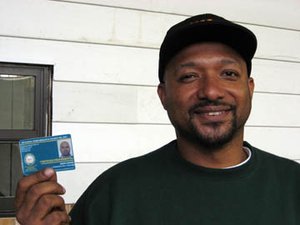Training for Green Jobs, Green Buildings

When Pratt Center Sustainability Project Manager Wendy Fleischer came to speak at a seminar on energy efficiency she had no idea that she was about to help Dion Lewis transform his life. Lewis was an unemployed maintenance worker, a single father who'd done seasonal work for the Battery Park City Conservancy. On that job he'd begun using biodegradable cleaning products, and it opened his eyes to the idea that in his work he could be an agent to create a better environment. He also aspired to work in the building trades. "I'd always wanted to do some kind of construction but just couldn't get in - you had to know someone," says Lewis. Once Lewis heard about the emerging green building industry he made it his business to learn all he could about it, which led him to Fleischer's seminar talk. After he heard her speak about training opportunities in weatherizing homes and apartments for energy efficiency, he sprinted to catch her on the way out the door. Fleischer introduced Lewis to the Building Analyst class, leading to a Building Performance Institute certification. "I felt quite embarrassed that I couldn't afford it at the time,” Lewis recounts. “’Could you find funding for this for someone like me?’ I asked. And she said: keep in contact with me, and we'll see what we can do."
The cost of the training is fully reimbursable upon its completion, but when Lewis couldn't pay tuition in advance, Fleischer located temporary assistance through the Fifth Avenue Committee's Single Stop assistance program. In October, newly certified as a Building Analyst, Lewis was hired by the Community Environmental Center in Long Island City, one of the region's biggest energy efficiency contractors. He conducts energy audits – measuring rooms, conducting blower door tests to measure air leakage, and sealing up problem spots with caulking and insulation.
He's now preparing to enroll in the next level of training, Building Envelope classes that teach contractors best practices for sealing the exterior walls of a home. Lewis is now a member of the Laborers International Union of North America, and he plans to make energy efficiency work his career. "I did a home in Brooklyn for an elderly lady from the South, and it gave me great pleasure to actually go in there. She appreciated the service we rendered and I knew she needed it," he says. "My definition of a 'green-collar job' is that it's ecologically sustainable, economically sustainable and socially sustainable, and this job gives me all three."
As coordinator of NYSERDA's Energy $mart Communities program for Brooklyn and Queens, the Pratt Center has been helping contractors like Lewis find their way to training in the growing field of green-collar jobs. The Association for Energy Affordability and the Center for Sustainability offer training courses for contractors at various locations in the five boroughs, with tuition of $1,245 reimbursed by NYSERDA upon completion. Those courses lead to certification by the Building Performance Institute, which is required for all contractors participating in NYSERDA energy-efficiency programs. "I'm delighted to have been able to introduce Dion to the classes NYSERDA sponsors for contractors," says Fleischer. "Retrofits are a fast-growing field, and those who join now will be at a competitive advantage as it develops."The Pratt Center also offers its own training programs for building owners and contractors seeking to make homes healthier, reduce energy costs and improve the environment. Managing Lean and Green is a monthly series of workshops, running through June 2010, targeted at managers of affordable housing. The series is cosponsored by the Association for Neighborhood and Housing Development and the Supportive Housing Network of New York.
See Dion Lewis and the Pratt Center’s Energy $mart Communities training outreach featured in The New York Times.